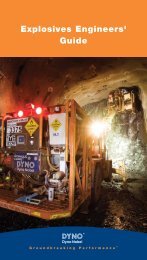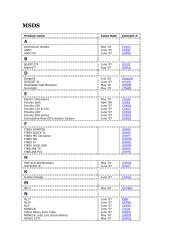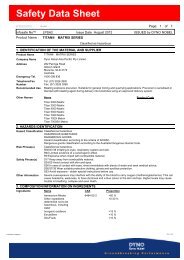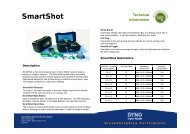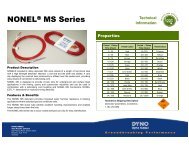Blasting and Explosives Quick Reference Guide 2010 - Dyno Nobel
Blasting and Explosives Quick Reference Guide 2010 - Dyno Nobel
Blasting and Explosives Quick Reference Guide 2010 - Dyno Nobel
You also want an ePaper? Increase the reach of your titles
YUMPU automatically turns print PDFs into web optimized ePapers that Google loves.
Glossary<br />
Airblast Airborne shock wave resulting<br />
from the detonation of explosives.<br />
Back break Rock broken beyond the<br />
limits of the last row.<br />
Borehole pressure The pressure which<br />
the gasses of detonation exert on the<br />
borehole wall.<br />
Charge weight The amount of explosive<br />
charge in kilograms.<br />
Column charge A continuous charge of<br />
explosives in a borehole.<br />
Critical diameter The minimum diameter<br />
for propagation of a stable detonation.<br />
Cutoffs A portion of an explosive<br />
column that has failed to detonate due to<br />
rock movement.<br />
Decoupling The use of explosive products<br />
having smaller volume than the volume of<br />
the blasthole it occupies.<br />
Delay blasting The use of delay<br />
detonators or connectors to separate<br />
charges by a defined time.<br />
Density mass per unit volume.<br />
Detonation pressure The pressure<br />
created in the reaction zone of a<br />
detonating explosive.<br />
Explosive Any chemical or mixture<br />
of chemicals that can react to produce<br />
an explosion.<br />
Free face A rock surface that provides the<br />
rock with room to exp<strong>and</strong> when blasted.<br />
Flyrock Rock that is propelled through<br />
air from a blast.<br />
Fragmentation Measure to describe<br />
the size of distribution of broken rock<br />
after blasting.<br />
Ground vibration Ground movement<br />
caused by the stress waves emanating<br />
from a blast.<br />
Initiation The act of detonating explosives<br />
by any means.<br />
Line drilling A method of overbreak<br />
control which uses a series of closely<br />
spaced holes that are not charged.<br />
Loading density The weight of explosives<br />
per metre of borehole.<br />
Maximum Instantaneous Charge (MIC)<br />
Mass of explosive detonating in some<br />
defined time period, usually 8 milliseconds.<br />
Overbreak Excessive breakage of rock<br />
beyond the desired excavation limit.<br />
Particle velocity The speed of movement<br />
in a given direction of a rock or soil mass.<br />
Pre-split A controlled blast in which<br />
decoupled charges are fired in holes on<br />
the perimeter of the excavation prior to<br />
the main firing.<br />
Relative Bulk Strength (RBS) The energy<br />
yield per unit volume of an explosive<br />
compared to ANFO.<br />
Relative Weight Strength (RWS) The<br />
energy yield per unit mass of an explosive<br />
compared to ANFO.<br />
Spacing The distance between boreholes<br />
in the same row.<br />
Stemming Inert material used to confine<br />
the gasses generated during detonation.<br />
Swell factor The ratio of the volume of<br />
broken rock to the volume of in-situ rock.<br />
Velocity of detonation The velocity at<br />
which a detonation progresses through<br />
an explosive.




